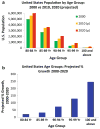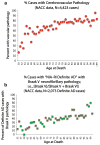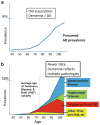Alzheimer's disease is not "brain aging": neuropathological, genetic, and epidemiological human studies
- PMID: 21516511
- PMCID: PMC3179861
- DOI: 10.1007/s00401-011-0826-y
Alzheimer's disease is not "brain aging": neuropathological, genetic, and epidemiological human studies
Abstract
Human studies are reviewed concerning whether "aging"-related mechanisms contribute to Alzheimer's disease (AD) pathogenesis. AD is defined by specific neuropathology: neuritic amyloid plaques and neocortical neurofibrillary tangles. AD pathology is driven by genetic factors related not to aging per se, but instead to the amyloid precursor protein (APP). In contrast to genes involved in APP-related mechanisms, there is no firm connection between genes implicated in human "accelerated aging" diseases (progerias) and AD. The epidemiology of AD in advanced age is highly relevant but deceptively challenging to address given the low autopsy rates in most countries. In extreme old age, brain diseases other than AD approximate AD prevalence while the impact of AD pathology appears to peak by age 95 and decline thereafter. Many distinct brain diseases other than AD afflict older human brains and contribute to cognitive impairment. Additional prevalent pathologies include cerebrovascular disease and hippocampal sclerosis, both high-morbidity brain diseases that appear to peak in incidence later than AD chronologically. Because of these common brain diseases of extreme old age, the epidemiology differs between clinical "dementia" and the subset of dementia cases with AD pathology. Additional aging-associated mechanisms for cognitive decline such as diabetes and synapse loss have been linked to AD and these hypotheses are discussed. Criteria are proposed to define an "aging-linked" disease, and AD fails all of these criteria. In conclusion, it may be most fruitful to focus attention on specific pathways involved in AD rather than attributing it to an inevitable consequence of aging.
Conflict of interest statement
Figures






References
-
- Consensus recommendations for the postmortem diagnosis of Alzheimer’s disease. The National Institute on Aging, and Reagan Institute Working Group on Diagnostic Criteria for the Neuropathological Assessment of Alzheimer’s Disease. Neurobiol Aging. 1997;18:S1–S2. - PubMed
-
- Pathological correlates of late-onset dementia in a multicentre, community-based population in England and Wales. Neuropathology Group of the Medical Research Council Cognitive Function and Ageing Study (MRC CFAS) Lancet. 2001;357:169–175. - PubMed
-
- Prevalence of stroke–United States, 2005. MMWR Morb Mortal Wkly Rep. 2007;56:469–474. - PubMed
-
- Sundt’s occlusive cerebrovascular disease. W.B. Saunders; Philadelphia: 1994.
Publication types
MeSH terms
Grants and funding
LinkOut - more resources
Full Text Sources
Other Literature Sources
Medical

